
Visit Shrines
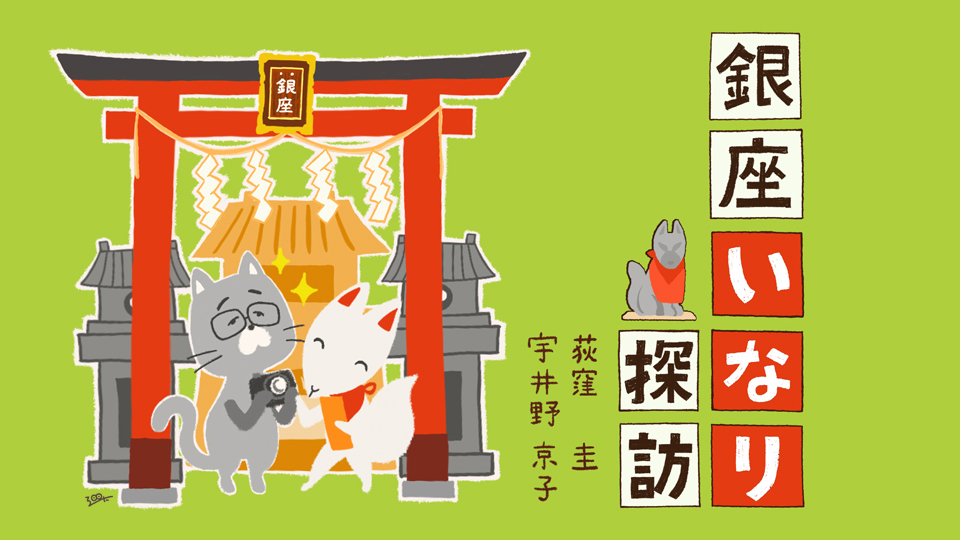
Visit Ginza Shrines Vol. 9 Saiwai Inari Shrine
2022.02.01
Isn’t the master of a long-established business your typical image of a town leader?
Of course, the masters of the large shops are the daily protectors of Ginza, but the younger merchants that follow in their footsteps are of equal significance.

- Ogikubo
- Isn’t the master of a long-established business your typical image of a town leader? Of course, the masters of the large shops are the daily protectors of Ginza, but the younger merchants that follow in their footsteps are of equal significance.
- Uino
- It is Reiwa 4. A lot happened last year, and I am so thankful that we can both be here today. Today’s Inari shrine is being protected by the younger generation. It is very promising.
- Ogikubo
- Oh, where is this shrine?
- Uino
- It is in Ginza 1-chome.
- Ogikubo
- Oh? … I think I may know it. Is it not the shrine in this picture?
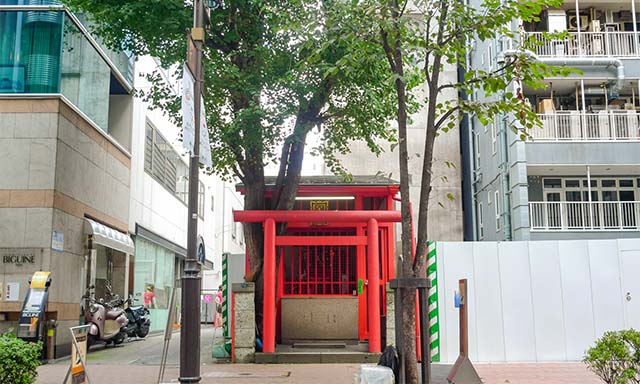
- Uino
- When was this picture taken?
- Ogikubo
- : September 2008. I thought I had taken it not so long ago. But it has been 14 years. I took a picture of it, surprised to see an Oinari shrine at such a location when I was taking a stroll through Ginza with my camera.
- Uino
- I see. Then, let’s go see how the shrine looks today.
- Ogikubo
- I am a little puzzled. The Inari shrine should be here along Namiki Street but it’s not. A brand new building is standing where it used to be.
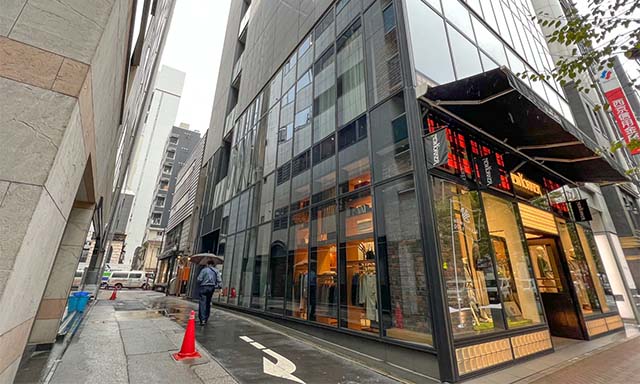
- Uino
- That’s right. The Inari shrine could not escape the impact of redevelopment and was moved a bit further from the main street. Redevelopment of this area should have taken place in 2008 but things did not go as planned due to the unexpected Lehman crisis among other events. As a result, ownership of the property was transferred, and redevelopment plans were drastically changed.
- Ogikubo
- Where does the Inari stand now?
- Uino
- You can see it in the alley at the side of this building.
- Ogikubo
- Oh, I see. There are directions on a boulevard tree standing close to its original location. It says, “This way to the Saiwai Inari Shrine.”
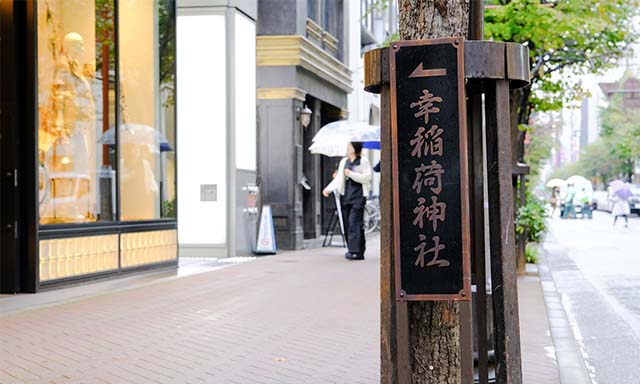
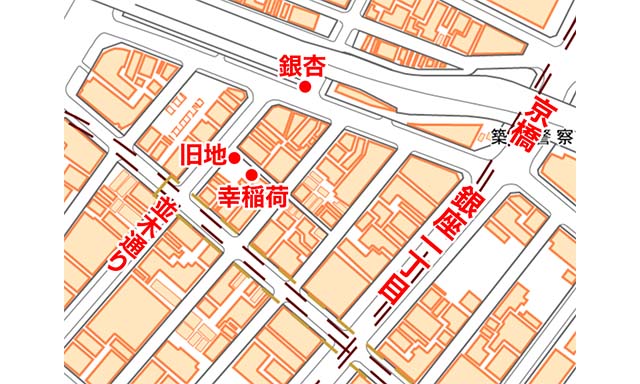
Source: Geospatial Information Authority of Japan website
当該地図を加工して作成。
- Ogikubo
- Oh, there is a small but new altar. So, it was moved here. It has been moved farther from the Namiki-dori but the altar is new and modern. And what is more, I’m so happy to see it remaining on a part of the premises.
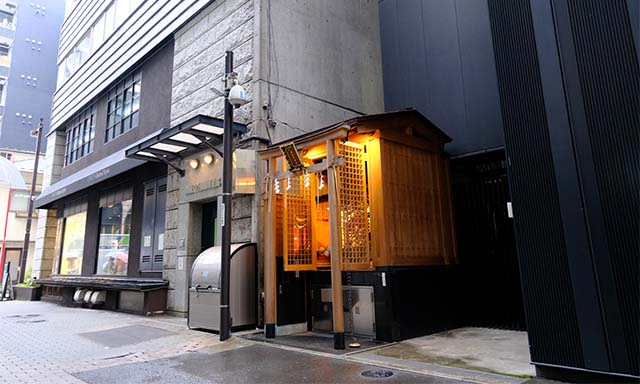
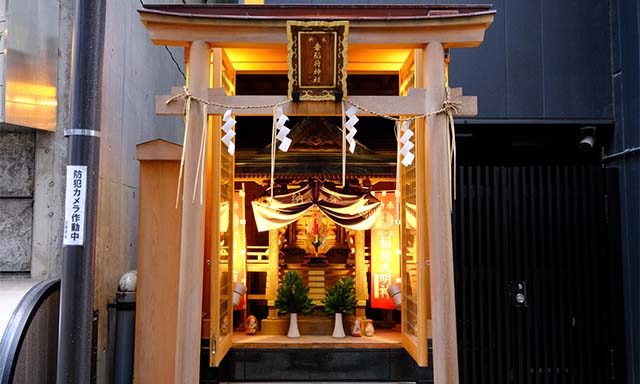
- Uino
- This Inari shrine was officially re-enshrined by the Fushimi Inari in ancient times. Its original name was Tachiuri Inari, but given a gentler and happier name, Saiwai Inari continues to protect the local people.
- Ogikubo
- In older times, there were katana and wakisashi sword merchants in this area, so it was often called by its nickname Tachiuri (太刀売, literally meaning “sword-trader”). However, it is written on Edo-Kiriezu of the late Edo period that this area is “called Tachiuri (立売, literally meaning “street trader”).” Therefore, there is a second version to the origin of its naming, which is that traders sold their goods standing along the riverbank. I am not sure which story is true, but I can say for certain that the Inari shrine protected an area where there were many Tachiuri traders.
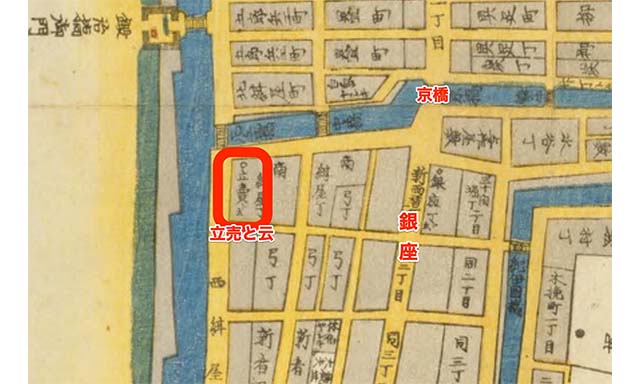
Source: “Tsukiji Hacchobori Nihombashi Minami-no-zu”
Edo Kiriezu (National Diet Library digital collection). Retouched relevant map.江戸切絵図「築地・八丁堀・日本橋南之図」。
当該地図を加工して作成。
- Ogikubo
- The Inari shrine cannot be found on the Edo Kiriezu. I imagine this is because it was a small town shrine. It seems to have been located closer to the river, back then. I purchased a map book called “Chuo-ku Enkaku Zushu” the other day. This Inari was drawn on the “Kahozu (fire map)” of 1947 (Showa 22). You have the same book, Uino-san, don’t you?
- Uino
- Yes, I ran to the library when I learned of it. This is really an interesting book. I forget the time when I am exploring. I think it will be useful for future Inari excursions. By the way, what is a “Kahozu”?
- Ogikubo
- Short for “Kasai Hoken Chizu (fire insurance map), it is a map for fire insurance calculations. Back then it was made to calculate fire insurance rates. It is very detailed with information about each house and is known by some people to be an old residential map. According to this, the property alongside Namiki-dori, is marked Inari.
![昭和22年の銀座一丁目。「中央区沿革図集[京橋篇]」 昭和22年火保図より。(東京都中央区教育委員会)。当該地図を加工して作成。](/wp-content/uploads/visit-shrines09_08.jpg)
(Chuo-ku Board of Education, Tokyo). Retouched relevant map.
- Uino
- It is a devout Shinto shrine from the Edo period. Even today, when it has during the festive season it is gloriously decorated with many streamers.
- Ogikubo
- I imagine it was a deity for commercial prosperity, as Ginza 1-chome is an old commercial district, located right next to Kyobashi, with a river bank where goods were loaded and unloaded.
- Uino
- It seems a “mikoshi” portable shrine made an appearance during festivals. The mikoshi still exists, but it is difficult to carry one around Ginza in modern times.
- Ogikubo
- Cooperation from the local community and many people is essential to carry around a mikoshi. By the way, new buildings have increased in Ginza, as a result of development projects. Are there fewer private stores and old businesses continuing business in the area?
- Uino
- Yes, it has become difficult to run a business in a big city without the backbone of corporations and investors. But the people taking care of this Inari shrine are the young keepers of local businesses who were born and raised in Ginza. The youngest of the young, so to speak. These days these young storeowners of long-established businesses get together and come up with new ideas for local events. A relaunch of mikoshi carrying may not be so far in the future!
- Ogikubo
- It would be exciting to see a mikoshi walking through the streets of Ginza.
- Uino
- Their young energy may make this dream true. There is another sign of hope that the Saiwai Inari shows us.
- Ogikubo
- Oh, what is it?
- Uino
- It is the holy ginkgo tree that used to stand on the shrine premises.
- Ogikubo
- Ah, it is in the picture I took in 2008. There is a ginkgo tree in front of the altar.
- Uino
- The tree could not be replanted on the new shrine property, but followers cut off some of the branches and planted them in different places. One of them is just nearby so let’s go take a look. It is this way.
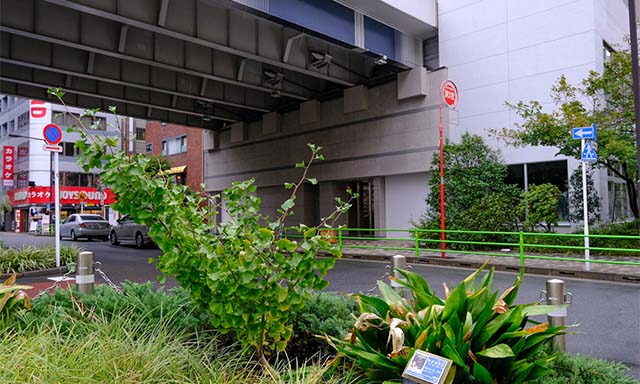
Still small, but sure to grow steadily.
- Ogikubo
- This is under the Metropolitan Expressway, where the former riverbank of Kyobashigawa River which ran under Kyobashi Bridge used to be. But there is no way of knowing that this is part of the gingko tree that used stand in the premises of the shrine. I think it would be a good idea to put up a sign here. A simple map of the way to the Inari may also be a helpful for walkers.
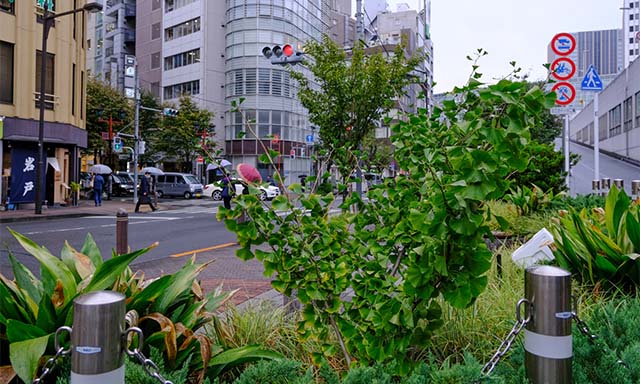
- Uino
- Yes. I am happy to witness the young ginkgo growing, firmly rooted in the ground. It is clear proof that the Inari shrine is being succeeded by the younger generation. The town of Ginza is going through rapid change, but I hope its good parts will remain. I hope the next generation will live in the Ginza with all its old charm.
- Ogikubo
- I think one of the appealing points of Tokyo is that old and new coexist.
All List
- 2020.05.01 Visit Ginza’s Inari Shrines Vol.2 Asahi Inari Shrine
- 2020.08.01 Vol.3 Exploring Ginza in the Edo Period on an old map
- 2020.11.01 Visit Ginza’s Inari Shrines Vol. 4 Kakugo Inari Shrine
- 2021.02.01 Visit Ginza’s Inari Shrines Vol. 5 Azuma Inari
- 2021.05.01 Visit Ginza’s Inari Shrines Vol.6 Kabuki Inari
- 2021.08.01 Visit Ginza’s Inari Shrines Vol.7 Ginza Inari in Ginza 2-chome
- 2021.11.01 Visiting Ginza’s Shrines Vol. 8 Kumagai Inari Shrine
- 2022.02.01 Visit Ginza Shrines Vol. 9 Saiwai Inari Shrine
- 2022.05.01 Visit Ginza’s Shrine Vol. 10 Mimeguri Shrine and Shusse Jizoson on the roof of Mitsukoshi Department Store
- 2022.08.01 Visit Ginza’s Shrines Vol. 11 Komparu Inari
- 2022.11.01 Visit Ginza’s Inari Shrines Vol.12 Mankin Ryujin Seiko Inari Shrine
- 2023.02.01 Visit Ginza’s Shrines Vol.13 Hachikan Shrine
- 2023.05.01 Visit Ginza’s Inari Shrines Vol.14 Hoju Inari Shrine
- 2023.08.01 Visit Ginza’ Inari Shrines Vol. 15 Ryuko Fudo-son
- 2023.11.01 Visit Ginza’s Shrines Vol. 16 Hodo Inari Shrine
- 2024.02.01 Visit Ginza’s Shrines Vol. 17 Toyoiwa Inari Shrine
- 2024.05.01 Visit Ginza’s Inari Shrines Vol. 18 Yasuhira Shrine
- 2024.08.01 Visit Ginza’s Inari Shrines: Final Edition








